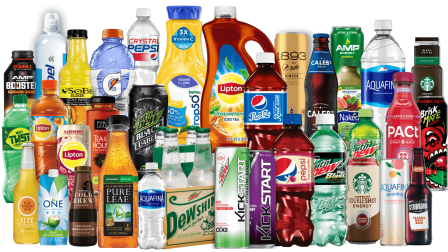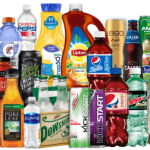A CMO’s View: For PepsiCo, martech is central to shaping the consumer experience
PepsiCo CMO Seth Kaufman shares how his teams are using martech across the brand’s entire product line.

After spending more than 15 years in a number of marketing leadership roles with PepsiCo, Seth Kaufman was named CMO for the brand in October of 2015.
Charged with leading the business, brand and consumer agenda for PepsiCo’s entire line of carbonated soft drinks, waters, teas, energy and ready-to-drink coffee beverages in the US, Kaufman says he has structured his teams to keep up with the pace of change.
“Our core brand groups are focused across three dimensions — innovation and strategy, which charts the long-term brand vision; communications, which crafts the platforms and strategies that move consumer passion and behavior; and commercial, which connects with and engages consumers at the moment-of-choice, in-store.”
According to Kaufman, his aim is to build diverse teams with talent from different backgrounds and expertise to foster the “most imaginative thinking” and generate the strongest results.
In an interview conducted over email, Kaufman shared how his brand is using marketing technology to shape the consumer experience across PepsiCo’s product lines, and why martech is at the center of his brand’s campaign strategy.

Seth Kaufman
CMO @ PepsiCo
Takeaways:
1. Stay agile: As the old saying goes, the only thing that is constant is change. This means using technology and tools to listen to consumers and transform your products and marketing strategy accordingly.
2. Be authentic: Reach fans by engaging in areas that are already meaningful to them, whether it’s a key moment in time or through a specific platform.
3. Invest in your talent: Your company and brand’s strategy is only as strong as your team, and it must be a diverse team with talents and experiences that match today’s new challenges.
Amy Gesenhues: How would you define the PepsiCo consumer experience?
Seth Kaufman: We put the consumer at the center of everything we do at PepsiCo.
We do this through a lot of ways — providing innovative and refreshing product choices, creating engaging digital content, giving access to one-of-a-kind experiences, partnering with the celebrities and athletes they love, and so much more.
In fact, we even have a catalyst group within my team called PepsiCo Creator that’s dedicated solely to innovation. They look at new technologies, find new partnerships and test new ideas. One of the group’s key goals is to create an advantaged pipeline of scalable marketing platforms that deliver brand growth.
AG: What are the biggest differences in consumer experience when you drop down to the individual brand level between PepsiCo’s product line?
SK: One of the coolest parts of our jobs at PepsiCo is listening and learning from our consumers to, in turn, create products and experiences that meet their specific needs and expectations. I’d say that’s the biggest difference in HOW consumers use each brand.
There are some fundamental marketing approaches we take across most brands. Each needs a content and influencer strategy, for example. The differences are in how we approach this for each.
When building our influencer networks, we focus on something we call LATTE: local, authentic, transparent, traceable and ethical. When we hone in on our individual targets for each brand, the result is very different.
Another example is Lipton Iced Tea. We understand that tea is a connector in a way that other beverages aren’t, and that the taste profiles lend themselves to a wider range of refined culinary experiences. So we built a program with “Chef Fests” in key markets, hosted by celebrity chef Michael Symon.
These were a series of events that had the common goal of encouraging consumers to connect with their loved ones in a way that’s meaningful to them with the help of Lipton.
We’re enjoying a delicious spread at our final #LiptonChefFest in Austin tonight. Thanks to all who have contributed to this experience! pic.twitter.com/wYL4Y5hcta
— LIPTON® Tea (@Lipton) October 30, 2016
This campaign was driven by insights from our target that there’s a desire to unplug, be present and bond with friends over a meal.
For STUBBORN Soda, a line of craft sodas, the same strategy plays out much differently. We created a content series that profiled individuals who showed courage in following their passions and bringing their dreams to life, all the while disrupting convention in order to achieve better results.
This is the spirit behind the brand, which was actually created by a small group of millennial employees passionate about re-imagining soda. For this, we partnered with Robert Kirkman, creator of “The Walking Dead.” He’s someone who truly embodies STUBBORN’s brand values and its edginess in particular.
AG: How does your marketing technology stack fit into your overall marketing strategy?
SK: In addition to being highly targeted media-wise, our brands are primarily marketed digitally and experientially, and we rely on technology to do this in culturally relevant ways. Technology is a huge driver of the consumer experiences we create, that in turn generate earned and shared media.
So I would say it’s less about the delivery channels and more about the cultural passion points we choose — the connective pop-culture platforms we select as experiential launching pads for each brand.
Where does it make sense for this brand to be? And, once we’re there, how do we use technology to engage the consumer in a connective experience? These are the questions we try to answer every day.
AG: How does PepsiCo use martech to differentiate its brands?
SK: A big part of all of this is how each brand responds to the explosion of data that’s now available to help shape programs, and how the democratization of influence informs who each brand chooses to partner with and why.
The differences between brands are mostly in the substance of how these fundamentals are applied: what is the substance of the message, how is it delivered, and with whom?
AG: Can you offer a specific example of a marketing technology that is helping shape the PepsiCo consumer experience?
SK: While there are a lot of examples, something we’re really excited about and passionate for right now is virtual reality. Importantly, having the right intelligence from various data sources up front allows us to give consumers a VR experience we know will resonate strongly.
The power of VR (done well) is giving PepsiCo — and companies, in general — a way to engage with consumers on a much deeper level, immersing them 100 percent with cutting-edge experiences that reach them everywhere and anywhere.
Specifically, this is something we’ve jumped into head-first with Mountain Dew. This brand is all about finding and creating awesome experiences for our biggest fans, who we call DEW Nation.
For example, at this year’s NBA All-Star Game in Toronto, Mountain Dew hosted an interactive event called Court Vision which featured the use of Google’s Tilt Brush to make basketball-inspired 3-D artwork. This is something our team is really proud and excited about since it brought Tilt Brush technology, an artistic tool, and married it to the NBA, a sports platform, in a dynamic and first-mover way.
It’s essentially offering the DEW consumer the opportunity to create and share through a dynamic experience.
AG: Among the marketing technologies you leverage, which has the biggest impact on your brands?
SK: Analytics is an enormous technological asset. To illustrate this, I’ll use the Pepsi Super Bowl Halftime Show as an example, which is one of our most important campaigns of the year.
Halftime is a 12 1/2-minute live spectacle, right smack in the middle of the most-watched event in the world. It’s the epicenter of pop culture, where sports and entertainment collide in front of 115 million households. For us, it’s also the culmination of a massive multifaceted experiential campaign.
You’ve probably read this stat several times, but it bears repeating: 90 percent of the world’s data was created in the last 12 months. And this figure will grow exponentially over the next decade, as we ultimately add 100 billion connected devices by 2025. Each one provides us with an opportunity to learn, adapt and market smarter and in more contextually relevant ways than ever before.
We use this data for more accurate predictions. What’s going to resonate? Can we pinpoint why and do we know when? It’s an enormous learning opportunity that makes marketing more of a science now in many ways — in part because it’s a method of observing, analyzing, hypothesizing and testing.
How do we prepare for the Super Bowl moment? Our digital, media, insights and analytics teams build an integrated data management platform, to prepare us for that sustained boom of data and allow us to effectively harness the power of all of our information.
It’s the data — knowing, for example, that the most-tweeted moment was the minutes immediately following the show — that allow us to engineer our approach the following year and be ready for anything.
AG: Where has martech had the most influence on the brand’s consumer experience?
SK: To continue the Super Bowl example: You go to the game or a viewing party and everyone is either capturing or consuming content on their devices the entire evening. Technology has truly transformed beyond a digital storytelling vehicle to a living, breathing platform.
Super Bowl is now an online affair. Over 3.9 million unique mobile viewers alone tuning in to more than 402 minutes of coverage. Sixty million Facebook users generating 200 million social interactions around Super Bowl.
Looking back on Super Bowl 50, the best part for me is that the most-tweeted minute was at 8:44 p.m. ET when 162,000 tweets were sent in the 60 seconds immediately following the Pepsi Super Bowl Halftime Show.
To me, that’s just one example of the transformative power of technology and how marketers need to rethink our game plan.
AG: Can you share a specific campaign where martech played a primary role in how PepsiCo connected with consumers?
SK: Marketing effectively today requires a mindset that’s not only made for technology, but also marketing that is about technology. For example, last summer we launched #SayItWithPepsi, an emoji campaign with a mobile-first execution.
As part of the campaign, we created more than 100 highly contextual five-second TV spots that tapped into key moments like MLB All-Star Week and the CMT Awards Show.
If you think about the power of contextually relevant creative on this micro-basis, it allows you to use the data you have on various consumers to best resonate at a specific moment in these consumers’ lives, and that’s powerful.
The five-second spot was an approach that had never been done and was a way for us to connect with consumers in a very effective way.
Technology has evolved and is a pop culture subject in its own right. At PepsiCo, we’re approaching technology in this way by making it the center of our activations and campaigns.
AG: What have you learned about your audience from your marketing technology efforts?
SK: We’re learning something new every day from one data point or another that in turn we translate into our practices, strategies and specific executional tactics. I think one key takeaway that comes to mind is that what we put on-screen is just as important as how we connect with consumers off-screen.
We live in a world where mobile is king, and in turn, creativity has been democratized. This goes back to the principle of listening because now the consumer is the artist, the advertiser and the distributor thanks to technology.
Marketing Land – Internet Marketing News, Strategies & Tips
(131)








